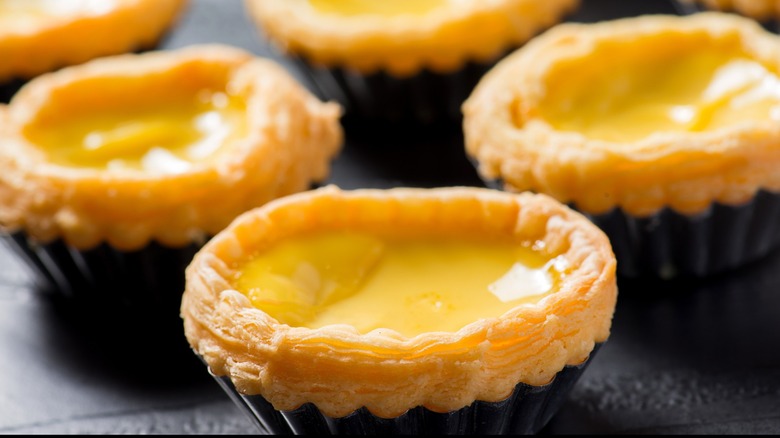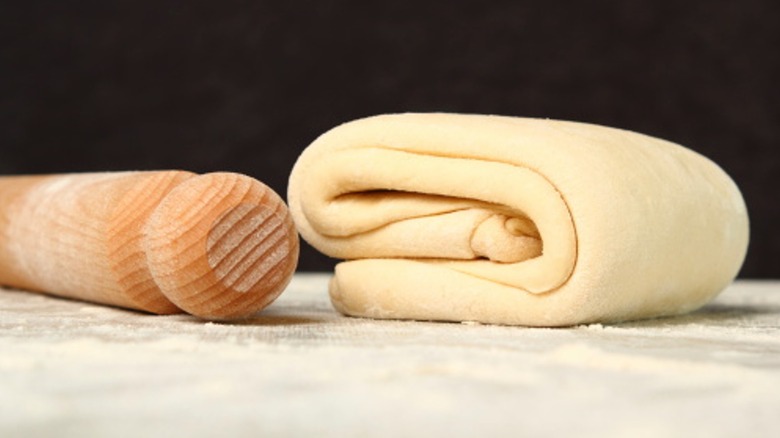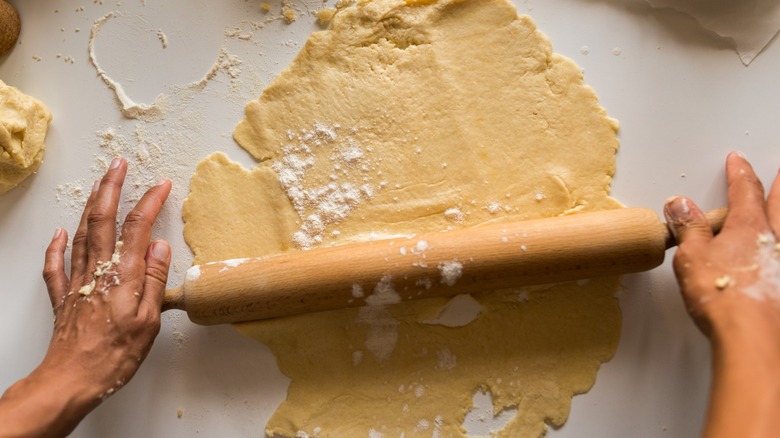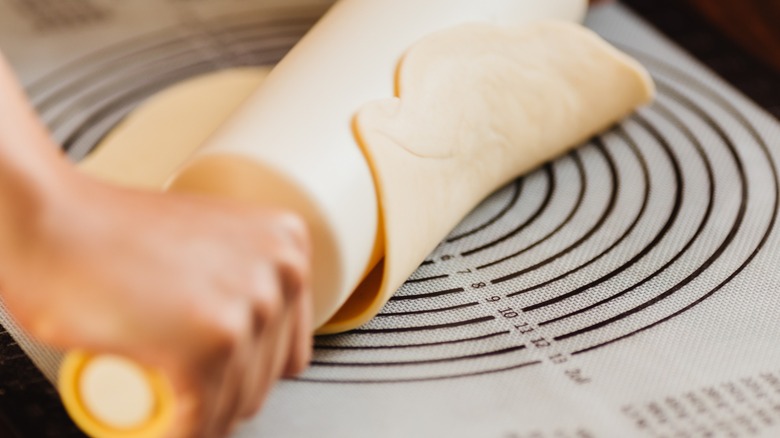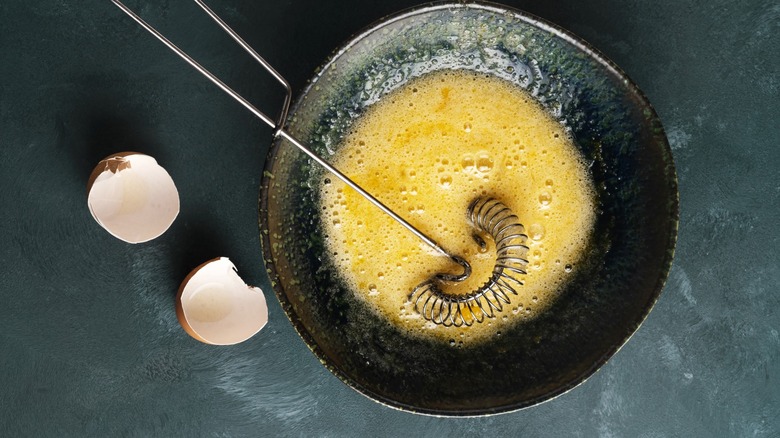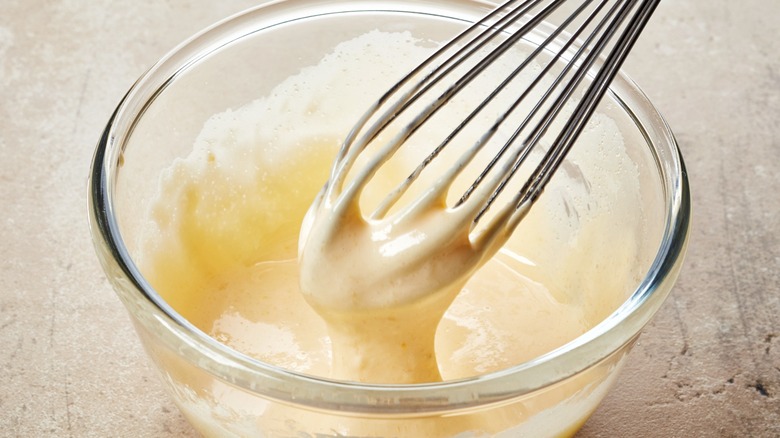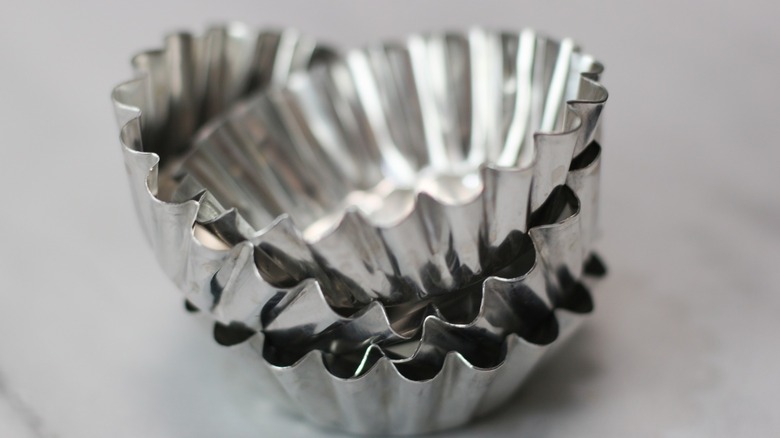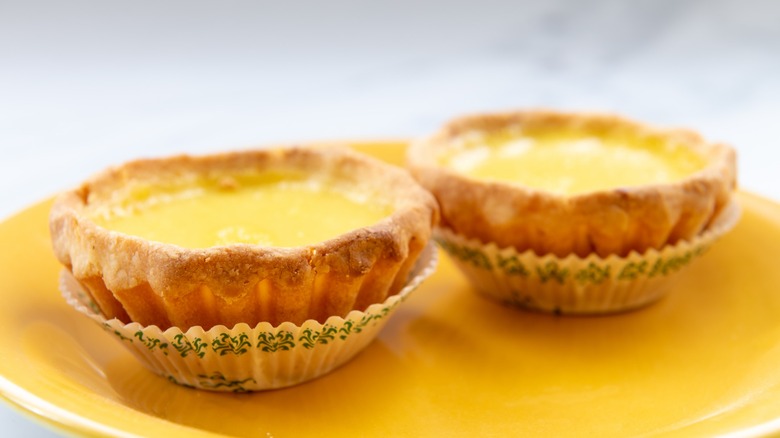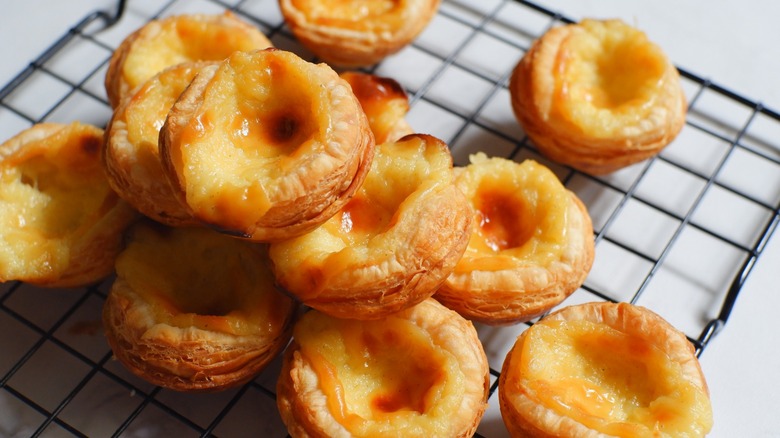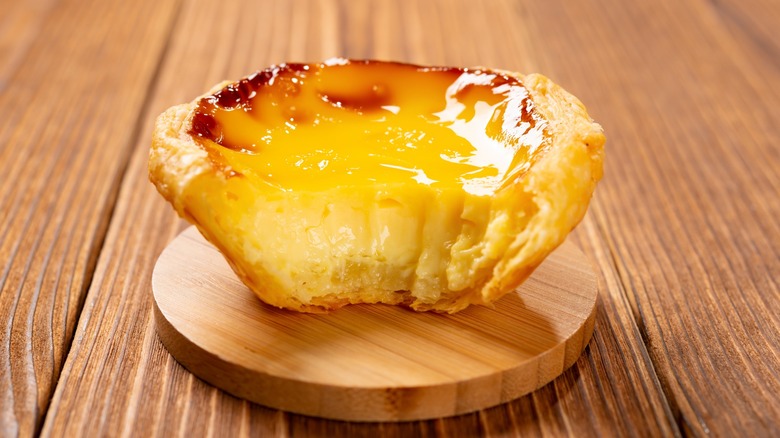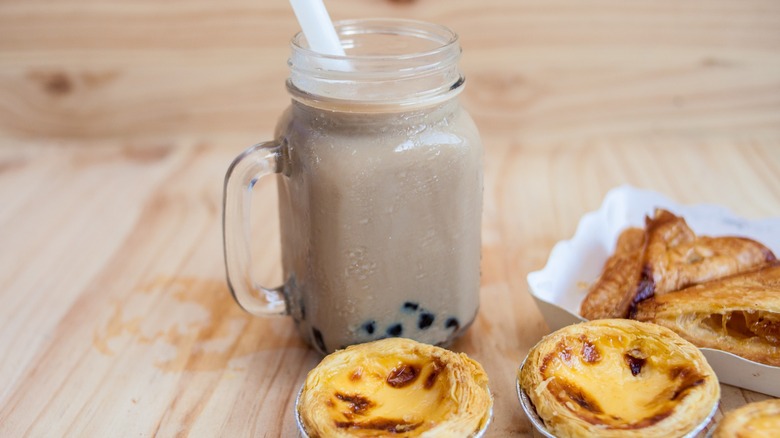11 Tips For Making Eggs Tarts
When we talk about egg tarts, what comes to mind? There are a few versions out there, and they're all pretty similar. Here, we're talking about the Hong Kong-style tarts, also known as daan tat. Often confused with the Portuguese version, called pastéis de nata, daan tat has a few marked differences. Generally speaking, because there are likely as many recipes out there as there are bakeries, the Hong Kong version came from British colonizers, while the Macau version is inspired by the Portuguese, and those origins contributed to the final recipes.
Portugal's pastéis de nata are unique because they're made with a whole lot of egg yolks (about six yolks per cup of milk) instead of the whole eggs that make the filling for daan tat. This makes the Portuguese version much richer and vibrantly colored, while Hong Kong's has a more delicate flavor and softer shade. Daan tat is mostly just eggs, sugar, and milk, with the occasional addition of vanilla. Pastéis de nata will often be flavored with orange zest and a sprinkle of cinnamon, giving them a definite dessert-like finish.
Finally, you can easily tell them apart just at a glance as pastéis de nata are cooked until the tops caramelize and develop deeply burnished spots on top, while standard daan tat has unblemished, soft gold tops.
Decide what kind of pastry you want to use
If you want the real thing, Chinese puff pastry is the way to go when making Hong Kong-style egg tarts. The recipe is a little more intimidating than butter-based puff pastry, however. There are two separate flour layers used, one with butter and margarine (called oil dough) and the second one made with shortening (called water dough), rolled and chilled before the laminating process begins.
Once chilled, both doughs are rolled and folded together multiple times, which will bake into a ton of tender yet crisp, flaky layers. While puff pastry isn't generally thought of as a beginner's task, we all have to start somewhere, right? If you do have experience baking, this might be the recipe that helps you level up in the kitchen.
Not up to the task of laminating and rolling, followed by even more laminating and rolling? Fear not; you can always use pre-made puff pastry for a decent substitute, as we do in this Hong Kong-style egg tart recipe. Keep in mind that store-bought puff pastry might not have as many beautiful layers as handmade, but it's also pretty foolproof. If you're looking for a quick fill of tender, custard-filled tarts, you can even use frozen tart shells, and your secret will be safe with us.
Don't roll the pastry too thin
No matter which method you choose, a few things are universally important when making pastry. While puff pastry only requires a handful of simple ingredients — flour, fat, and water — it also requires temperature management and a gentle touch. In particular, be very careful to avoid overworking the dough, as that will lead to a denser, tougher finish. Too much rolling will break up all the butter and incorporate it into the flour, and you won't get loads of light, flaky layers that make puff pastry what it's meant to be.
As for temperature management, whatever type of fat you choose needs to stay cool enough that it won't start melting into the flour as you roll. Remember, the fat needs to be pliable so it doesn't shatter into a million tiny pieces, but it has to be cold enough that it doesn't melt. You're going for distinct layers of flour and fat, and lots of them.
Generally speaking, you should be placing the dough into the fridge for 30 minutes after every two rounds of folding, or more often if your kitchen is very warm. And don't make this big mistake when rolling out your pastry — rolling right to the edge or your sheet will seal the ends and inhibit puffing as it bakes.
Use a silicone mat to easily roll the pastry
Now that your dough has chilled sufficiently and it's time to start rolling let us give you a little advice. Try using a silicone rolling mat rather than just dumping the whole thing on the countertop. Puff pastry, like most pastries, is delicate and needs to be handled gingerly. By using a silicone mat, you're going to find it easier to move around, and that will ultimately give you a better result. This is especially important if you've decided to try the Chinese pastry version with its two types of dough. If the water dough layer rips, the oil from the oil dough layer will seep out, and you'll just end up with a soggy mess. In fact, layering Chinese puff pastry between a silicone mat and a top layer of plastic wrap can work even better.
For French-style butter puff pastry, store-bought or homemade, a silicone mat will still reduce tearing and facilitate easier moving when folding, turning, and returning to the fridge between each cycle. Unlike parchment paper, it also stays in place better, and, if you're lucky, yours also has a ruler printed on it, making it easier to follow the guidelines for the size of that rectangle of raw, butter-filled dough.
Use the specified ingredients
Hong Kong egg tarts aren't really known for having multiple varieties. Mostly, they're all the same, and this is a big part of the appeal because you can order them from a Chinese bakery or at the end of dim sum, and you know what you'll be getting. Crisp flaky pastry and a rich egg custard don't really need much more than that, honestly. Doubly so when you're trying these on your own, especially for the first time making pastry. If you've landed on a recipe that doesn't suit you, instead of messing around with the ingredients, try a different version instead of modifying haphazardly.
When it comes to the custard, some recipes call for evaporated milk. While some do call for vanilla, that addition is mostly found in Americanized versions; otherwise, the filling doesn't usually have any additional flavors. In Portugal or Macau, egg tart versions often have a little cinnamon or orange zest, but in Hong Kong, the lightly sweetened richness of egg yolks is the star. Finally, Hong Kong-style tarts are known for their glossy, shiny filling, which relies on a specific amount of sugar to achieve — so don't even think about going with any less.
Strain the filling to ensure it's smooth
Making custard can be intimidating if you've never done it before, but once you have, you'll never look back. Fortunately, most recipes for egg tarts make custard that gets cooked in the oven rather than on the stovetop, so we can all be thankful for that. Custard is the basis of many delightful desserts and a few savory dishes as well. Before you get too excited about imagining all the fancy coconut cream pies and trifles you'll be whipping up, here are a few things to take into account when making the smoothest custard possible.
Even though it gets baked in the oven, temperature is still an important part of the process. If your recipe requires heating a liquid so that the sugar dissolves, make sure that you're not adding hot liquid to raw eggs. You want a smooth finish, not a bowl of sweet scrambled eggs. Next, whisk the mixture well so that all the ingredients are incorporated thoroughly and completely. However, all that mixing has likely left bubbles on the surface, and those will impede the perfectly smooth and glassy finish of your daan tat filling. Slowly strain the custard through a fine sieve to remove the air bubbles as well as any bit of egg (like the anchors in the whites) that might be left.
Mini tart molds are traditional but muffin tins work
When your pastry is cool and rolled out, you have yet another choice to make. Egg tarts can be made in a few styles, from diminutive fluted tart molds to a basic muffin tin version. Either way, you want to roll the pastry out to 0.2 inches (5 millimeters) thick gently and carefully. Using a cutter that is slightly larger than your tin, cut out as many circles as possible. In order to keep your pastry from getting overworked, you're going to want to cut the circles out as efficiently as you can — rerolling the leftover dough should only be done once; after that, the dough scraps can be made into some pretty tasty, old-school appetizers for a quick snack.
If you like the look of the fluted version but don't have fluted tart molds, pick up a simple scalloped cookie cutter and use muffin tins or aluminum tart cups. You'll have a finished product that's pretty close to the real thing without having to wait for that pesky online delivery. If the recipe that you're using doesn't have instructions for a muffin tin, we suggest adding anywhere from two to five minutes to your baking time, as opposed to the quicker baking time of individual tart tins.
Don't let the custard puff up too much
If you've taken a spin through your cookbooks or any online sites to see what these little beauties actually look like, you've likely noticed one thing. They're all uniformly shiny with gloriously flat surfaces and none of the caramelization of the Macau version. Daan tat is incredible in its visual sameness because of its careful baking techniques. Straining goes a long way to making the filling look perfect, but oven temperature and rack placement also play an enormous role in the beauty of the finished product.
Now ... here's the bad news. Puff pastry is generally baked at 400 F in order to get those layers puffing. But that kind of temperature will also make the filling swell up, which sounds fine until it hits the cool air and sags unappealingly. So what's an egg tart-craving baker to do? By setting the oven rack a little lower, the pastry gets the heat it needs in a shorter period of time. It's all just delicious science. Take care not to overfill — leave about ¼-inch of space — so that the baking custard has just enough room. When you think they've finished cooking, give them a little jiggle to ensure the filling is set.
Let them cool slowly to minimize sinking
While we wouldn't turn up our noses at a collapsed tart, they have definitely puffed up and cooled too fast. The sunken filling is the whole reason you have to be aware of temperature, both in the oven and afterward. One of the best reasons to bake daan tat at home is that they're really better when eaten fresh and warm. But not too warm ... they need a few minutes to cool and settle before you can start enjoying them. One of the best ways to avoid that sad little depression (an apt description if we've ever heard one) is to let your tarts cool slowly. This is especially helpful if you've noticed a lot of puffiness while they've been cooking.
Once the filling has cooked, turn off the oven and crack the door to let the heat escape faster. The slow cooling will help to avoid too much sinking as the tart filling stops cooking. It will only take about five minutes for adequate cooling, and you'll be eating fresh oven-baked egg tarts before you know it.
Remember they're only good for a few days
Egg tarts of any kind are definitely best right out of the oven while they're warm and crisp. If you've made a large batch and need to store some away, it can be done. If you've got a lot of dough and filling, consider only making what you need over right now instead of baking up two dozen all at once. Both the dough and the filling will be fine stored in your fridge, properly covered, for the next 24 hours.
If you're not sure how many you're going to make, remember that leaving puff pastry at room temperature isn't the best idea. Cut enough to get started and then wrap up the remainder and pop it back into the refrigerator. Letting it sit out increases the odds that the fat will melt into the dough, negating the possibility of all those light, crisp layers. If you notice the dough is getting too soft as you work it, give it 20 to 30 minutes in the fridge to cool down. And again, try not to overwork the dough. Too much rolling and re-rolling, and you'll just end up with flat and dense tarts.
Don't use a microwave to reheat them
Tarts are best when you can get them warm and fresh. So what can you do with the leftovers? This might not be the way your parents did it, but popping them into an air-fryer is probably the best option for day-old daan tat. We can't deny the old-school attraction of using an oven (or even a toaster oven) — the thing is that an air fryer is just faster and often will give more consistent results. Using an air fryer only takes about 5 minutes at 300 F, so it's faster and still delicious. All that without heating up a huge appliance? We're thankful for the advances in technology, you know.
If you're using a regular or toaster oven to reheat your daan tat, you'll want to set it hot enough to crisp the pastry but for a short enough time so as not to cook it. Set the oven closer to 400 F and aim to toast the tarts for no more than 3 minutes.
Overall, the last thing you want to do is pop daan tat into the microwave. A couple of seconds may take the chill off, but more than that will turn the bottom deeply soggy and develop a weird, lumpy, unevenly wet custard. After all the hard work that went into this sweet little snack, why ruin it at the last minute?
Serve them anytime from breakfast to dessert
While you might be familiar with egg tarts as the last plate at your local dim sum joint, daan tat is actually eaten at any time of day. If you've ever had the pleasure of going to Hong Kong (or anywhere in China, really), you'll know that there is absolutely no reason not to eat incredibly well. The streets are lined with food vendors from a very early hour, and bakeries especially open before sunrise in order to feed commuters and workers. Egg tarts are popular first thing in the morning because they go so well with tea but also because they're filled with protein and aren't overly sweet.
These popular tarts aren't just for breakfast, though. The creamy but not overly sweet filling makes them a perfect accompaniment to a cup of tea, whether boba or oolong, any time of day. Their diminutive size makes them perfect as a rich finish to your meal or as a meal itself if you gobble up two or three.
